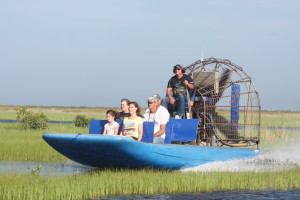 Airboats are an iconic sight to see in the Everglades. The thought of going on airboat tour adventure can be exciting. It’s fun to think about the seemingly endless acres of swampland the boat will travel through and all the plant life and wildlife that could be spotted during a trip. This is your chance to be in the water with some ‘gators! However, the thought of going on an airboat tour can also be nerve raking, because accidents can happen.
Airboats are an iconic sight to see in the Everglades. The thought of going on airboat tour adventure can be exciting. It’s fun to think about the seemingly endless acres of swampland the boat will travel through and all the plant life and wildlife that could be spotted during a trip. This is your chance to be in the water with some ‘gators! However, the thought of going on an airboat tour can also be nerve raking, because accidents can happen.
Many people have concerns, worries and fears about getting on an airboat. Airboats aren’t known for being unsafe, but collisions have occurred throughout the years. Nature can be unpredictable, so airboat safety is extremely important to ensure a successful excursion.
Captain Mitch has been in the airboat tour business since he was a young boy, following in the footsteps of his great grandfather, who built one of the first commercial airboats in 1945. He has more than 30 years of experience chartering through the Everglades and prides himself on bringing people on memorable and safe airboat tours.
Airboat captains will instruct passengers on safety precautions before the trip. Below are some of the safety measures and guidelines that airboats must meet, according to the Florida Department of Environmental Protection, that help to insure an airboat trip will be a safe experience:
- Propeller Safety. No one is allowed near the propeller. Loose items and clothing can get caught in the propellers causing damage to both the vessel and the body of a person. All items and equipment must be secured.
- Safety Equipment. Airboats are vessels and most meet Class A and Class 1 safety requirements for a recreational vessel. Airboats must be equipped with: ear protection, eye protection, first-aid kid, cell phone in a water-proof buoyant case, drinking water and a B-1 type approved fire extinguisher.
- Pre-Operation Checklist. Before operation, the captain will check the boat to make sure everything is performing properly to avoid accidents, injuries, and mechanical breakdowns.
- Weather. South Florida is a tropical climate, so weather can be unpredictable; high winds, lightening, and harsh rains are common in the area. Captains make themselves aware of the weather forecast and keep an eye on it throughout the day. Airboats will be docked when lightening, thunderstorms or high wind is spotted or experienced. Airboats will operate in fog, but will drive slower and turn on their strobe lights.
- Navigation: Airboat captains are trained in proper maneuvering and navigation techniques to get through tight areas and blind spots. They are also familiar with the area, so in case of an emergency, they can report where the boat is located.
- Obstacles: Captains are constantly on the lookout for other boats and their surroundings.
- Preventative maintenance: Each week, captains will conduct procedures to keep the airboat clean and working efficiently. The boat gets the propeller, exhaust system, oil, engines and much more checked for signs of aging.
Captain Mitch has been venturing out on an airboat for most of his life. He is comfortable navigating through the Everglades. For generations, Captain Mitch and his team have delivered fun and safe airboat rides throughout the South Florida wilderness. To schedule a ride through the Everglades, contact Captain Mitch’s Everglades Airboat Tours at 239-695-3377.






